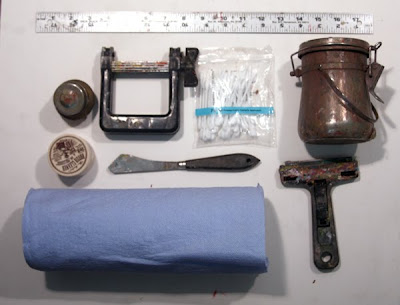My pallet: all Winsor Newton brand unless otherwise stated
cadmium lemon, cad yellow, cad yellow orange, cad orange(Gamblin), cad red light(Da Vinci), magenta(Old Holland), transparent red ochre(Le Franc), winsor violet, french ultramarine, cerulean blue, cobalt turquoise(Grumbacher), viridian, ivory black, titanium white(Da Vinci)

My brushes:
I use a large 2 inch Robert Simmons synthetic sable flat, Robert Simmons Signet bristle filberts ranging in size from 2 to 10, and Langnickel mongoose sable brights from 2 to 10, Robert Simmons synthetic sable rounds 1 to 3.

My mediums/thinners:
To add viscosity and speed the drying time of my paints I typically use Galkyd. To cleanse my brushes while painting and to cut the Glakyd I use Gamsol.

Misc:
Moving clockwise from the upper left, a small container for my Galkyd, a paint ringer for salvaging, the remnants in my paint tubes, cotton swabs for working with thin paint, a medium size container for my Gamsol, paint scraper for cleaning my pallet, shop towels, old masters brush cleaner for cleaning my brushes at the end of the day, and in the middle a pallet knife.

Most of these materials can be purchased at one of the two art store linked in the upper right corner of this blog, they are the two I most often use.
I will do a separate post on how I prepare my painting surface, but in the mean time I use gessoed hardboard.

2 comments:
Thanks for an insightful post. I'm always curious about the material and methods of other painters. You do some fantastic work. In your post you mentioned using q-tips for thin paint. Could you elaborate? What can a q-tip do that you couldn't just use a brush for?
B.
I use Q-tips to pick out transparent whites in thin paint, rather than use opaque white paint. This maintains a better feeling of luminosity and avoids the chalkyness that comes with white paint.
E-
Post a Comment